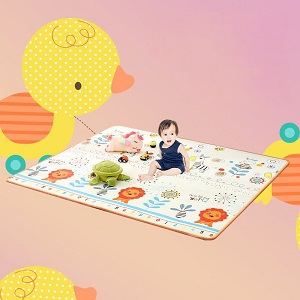Play mats have emerged as versatile tools that cater to children’s developmental needs in various ways. One of their most significant roles is providing sensory stimulation, a crucial aspect of early childhood development.
Sensory experiences play a vital role in shaping a child’s perception, cognition, and overall growth.

Impacts and Benefits
In this article, we will explore the profound impact of play mats on children’s sensory stimulation and its wide-ranging benefits. If you have some interest, you can read on.
1. Visual Stimulation
Play mats often boast vibrant colors, intricate patterns, and captivating designs. These visual elements immediately capture a child’s attention and encourage them to explore the mat’s surface.
As children focus on the details of the mat, their visual senses are stimulated, promoting visual tracking, pattern recognition, and the development of visual acuity.
2. Auditory Engagement
Many play mats incorporate auditory elements, such as sound effects or music. These auditory cues create a multisensory experience, enhancing children’s engagement with the mat.
By responding to their actions with sound, play mats promote cause-and-effect understanding and stimulate auditory processing skills.
3. Tactile Exploration
Textured surfaces and interactive components on play mats offer tactile sensations that captivate a child’s sense of touch. Whether it’s feeling different textures or pressing buttons, these activities engage the tactile senses, promoting sensory integration and enhancing fine motor skills.
4. Proprioceptive Input
Certain play mats require physical engagement, like stomping, jumping, or crawling. These activities provide proprioceptive input, which contributes to body awareness and spatial orientation.
The pressure and resistance experienced during these movements contribute to sensory regulation and overall body coordination.
5. Vestibular Stimulation
Some play mats are designed to encourage physical movements that involve balance and coordination. Activities like spinning, rocking, or swaying promote vestibular stimulation, which helps children develop a sense of equilibrium and spatial orientation.
6. Emotional Regulation
Sensory experiences on play mats can have a significant impact on children’s emotional regulation. Engaging with sensory elements can provide comfort and relaxation, helping children manage emotions and self-soothe.
This is particularly beneficial during times of stress or overstimulation.
7. Cognitive Development
The rich sensory experiences facilitated by play mats contribute to cognitive development. As children engage with the mat’s features, they process information, make connections, and expanding their cognitive abilities.
Sensory stimulation fuels curiosity, problem-solving skills, and the development of abstract thinking.
8. Language and Communication Skills
Engaging with a play mat’s interactive features can stimulate language development. As children explore, parents or caregivers can label and describe different elements on the mat.
This verbal interaction fosters vocabulary expansion, comprehension, and language processing skills.
9. Adaptation to Different Needs
Play mats can be tailored to accommodate different sensory preferences. Some children may seek out intense sensory experiences, while others might prefer gentle and soothing stimuli.
Play mats can be designed to provide a range of sensory inputs, catering to individual needs.
10. Holistic Development
The holistic nature of sensory stimulation provided by play mats promotes well-rounded development. By engaging multiple senses simultaneously, play mats offer a comprehensive and integrated approach to enhancing children’s physical, cognitive, emotional, and social growth.

Conclusion
Play mats play a pivotal role in providing children with rich sensory experiences that contribute to their overall development. Through visual, auditory, tactile, proprioceptive, and vestibular stimuli, these mats create a dynamic and engaging learning environment.
By harnessing the power of sensory stimulation, play mats become valuable tools in nurturing children’s exploration, curiosity, and holistic growth.

